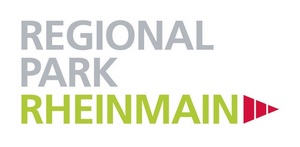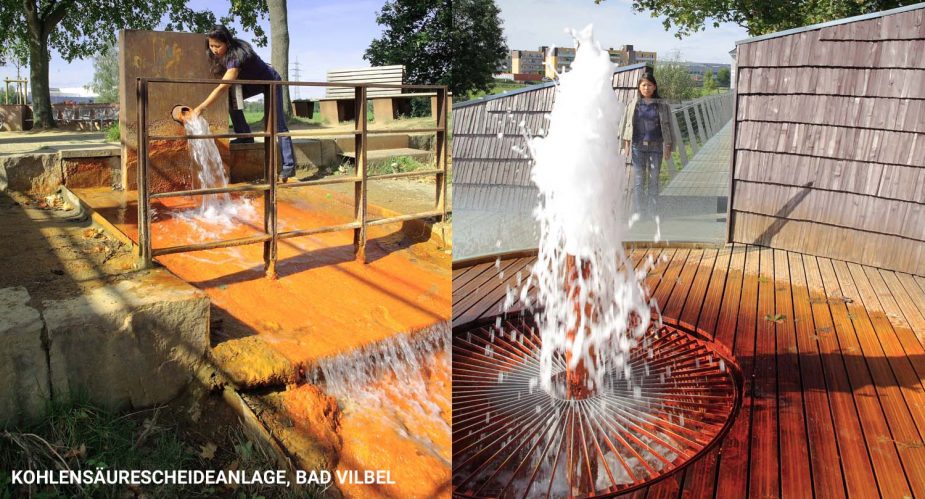At a glance:
Freizeitkarte: Niddaroute
Tour 9 - Water diversity in the Wetterau region
The liberated riverbed of the Nidda and the gushing mineral springs in Bad Vilbel play the main parts in this tour. The scenery, however, does not just consist of floodplains, it also includes orchards and the Frankfurt skyline. In the spa park of Bad Vilbel, we meet the best supporting actor of the tour, a sea god.
Numerous water creatures gather around the seagod Oceanus, who can be found in the centre of the Lebendiges Römermosaik in Bad Vilbel. The constructed floor once belonged to a Roman bathing complex; the original can be found in the Hessisches Landesmuseum in Darmstadt. The imaginative figures are showered with water so that they almost seem to come alive. Looking at this elaborately designed basin, you can easily imagine the significance of Roman bathing culture.
Nowadays, Bad Vilbel is known for its carbonated baths and drinking cures. The healing water originates from deep rock layers and releases valuable minerals on its way to the surface. You can get an impressive picture of the abundance of the natural mineral water and the use of its carbon dioxide content at the Römerbrunnen. The attractive carbon dioxide separation plant was designed by the Regionalpark and the Hassia Group. You can see the water that is separated from the natural carbonic acid flowing out – due to the high iron content it leaves unmissable traces. And on the opposite side of the Nidda, you can watch the water tirelessly bubbling from a depth of 287m.
In addition to the rich mineral water resources, we gain a very comprehensive impression of the dynamic river water of the Nidda, which can freely flow again thanks to the renaturation measures. The canal-like stone fortifications were removed and the river bed was considerably widened to enable the development of a natural watercourse with changing current speeds, gravel deposits, river bank erosion and an extensive floodplain. Today, the typical river ecosystem provides a habitat for animal and plant species that have become rare. The plan is also to settle sea trout here. It migrates from the Wetterau to the North Atlantic (home of our sea god) and then will hopefully return again.
Although the focus of the tour is on the Nidda, the smaller Nidder, which also originates in the Vogelsberg and runs parallel to the Nidda, should be visited briefly at its idyllic estuary in Gronau. A short distance further north, at the lookout point Gronauer Hof featuring bulrushes and a walk-in bird’s nest, you can enjoy the panoramic view of the floodplain landscape. And when the Regionalpark route runs close enough to the water, you can hear it rushing and murmuring quietly – this is a relaxing tour for the senses.
Another stream, the Erlenbach, accompanies us in the western section of the tour, surrounded by a diverse orchard landscape. From the small plateau of the Schäferköppel hill, we have a good view of its source area in the Taunus as well as of Frankfurt’s skyline.
The thematic circle of water closes in the spa park of Bad Vilbel. Directly at the Nidda, we pass the ruin ofthe Moated castle. As the residence of the Knights of Vilbel, its history dates back to the 12th century and it is surrounded by a wide moat. Mineral springs line the way – and at the end, the sea god greets us.
Directions
1. TOUR START is at the train station Bad Vilbel. From here, go straight ahead across Bahnhofsplatz to Friedberger Straße, then turn left and immediately right again into Heinrich-Heine Straße, where the typical Regionalpark marking, the red triangle, appears. After about 400 m, you will reach the Nidda and the Regionalpark Niddaroute, where you have to turn left to Dortelweil and Karben. From here, it is virtually impossible to miss the proposed tour.
2. After a few metres you will pass the KOHLENSÄURESCHEIDEANLAGE. About 1.7 km further, the markings will guide you to the other side of the river. At the T-junction on the open field, you will come across …
3. … the REGIONALPARK RUNDROUTE. This takes you to Okarben on the same route as the Niddaroute with the Nidda source as the main direction, and bicycle signposts to Karben. At the estuary of the Nidder, the route changes to the other side of the river, a little later on in the open field, you will pass the lookout point Gronauer Hof, then it goes back to the other side of the Nidda.
4. In Okarben, the REGIONALPARK RUNDROUTE turns left over the river and leaves it as you go straight ahead into the village. On the way to the nearby destination of Silberbornteiche and the long-distance destination of Friedrichsdorf, you will cross the railway tracks by means of a bridge.
5. At the B3, turn left to the traffic lights. On the other side of the road, the Rundroute leads you to Petterweil as far as Höfer Weg: On this road, turn left and continue straight ahead; the Rundroute leaves you here. Approx. 1 km after the Hof Kastanienhöhe, follow the main road to the right, and go left under the electricity pylons.
6. After the BRIDGE over the Erlenbach, turn left into the park and stay by the stream. The road leads you to the other side, where you will come across the street Am Steinberg. Turn right into the old town of Nieder-Erlenbach: Left into Zur Charlottenburg, left into the Alte Fahrt and diagonally right onto Bornweg. At the end, the route crosses under the L3008 and then bends back to Erlenbach. Continue along the stream and straight through Massenheim.
7. About 100 m after the END OF THE DEVELOPMENT: On the left, there is a bridge, a sign indicates Bad Vilbel. After the stream, cross the B3, then roll towards the Niddabank and left to Bad Vilbel. Back to the train station, ride to the point where you first encountered the river – turn left and take the familiar route back!
Downloads:
Food & Drink
Naturfreundehaus Karben:
naturfreunde-karben.de
Alte Mühle:
altemuehle.net
Café Wewe:
wewe-cafe.de









